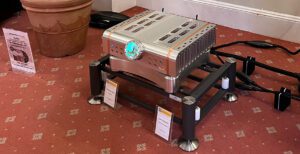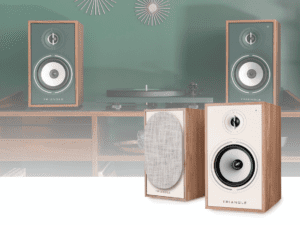
I spent this past weekend serving as the Hi-Fi+ emissary to the AXPONA 2014 show, held in the Westin O’hare Hotel in Chicago, Illinois, USA. For those of you not familiar with the show, let me begin by mentioning that AXPONA is an acronym that stands for Audio Expo North America. As such, the ambitious event occupies most of the available meeting spaces on the ground floor and on a lower level floor of the hotel, with many more demonstration rooms filling three of the hotel’s upper floors.
Unlike the CES or Munich High-End shows, and more like the Rocky Mountain Audio Fest, AXPONA is more of an enthusiast-centric than business-to-business-centric event, which works out beautifully for the serious (and passionate) listeners in attendance. The tradition at AXPONA is for many, though not all, demonstration rooms to be operated under the auspices of various local and regional high-end audio dealers and distributors, who are often ably assisted by manufacturers’ representative who provide assistance with set-up, room-tuning, and product adjustments, etc. The net effect, then, is much like visiting one’s favourite audio dealers or distributors, but on a special occasion where there are lots of factory trained product experts on hand to answer questions and provide insights.

No great audio show would be complete without live music and AXPONA did not disappoint. In particular, I was taken with a series of roughly hour-long mini-concerts given by the extraordinary virtuoso bass guitarist Dean Peer and his long-time musical collaborator percussionist Bret Mann. Peer and Mann’s set often featured music drawn from some of Peer’s earlier recordings (most notably the audiophile favourite Airborne), while also taking time to introduce some all-new material not yet captured on recordings. The new material, I must say, proved even more expansive, innovative, and both melodically and rhythmically adventurous than anything I have heard from Peer and Mann in the past. Their performances were breathtaking and reminded me of why I ever got involved in hi-fi in the first place.
AXPONA also features a seminar series and I am pleased to say that I, along with moderator Scot Hull of Part-Time Audiophile, Kevin Glendenning of JH Audio, Brannan Mason of Noble Audio, and Scott Houston of Sennheiser, took part in panel discussion and Q&A session on the topic, “What is the Right Headphone for You?” Audience members posed some great questions and I can only hope they enjoyed and benefitted from the session as much as I did as a participant.
As often happens with me, I returned from the show with far more information (with illustration photos to match) than could possible fit in a single show report. So, to impose some order on what could otherwise be chaos, I’m going to focus Part 1 of this report on Headphones, Earphones, Custom-Fit In-Ear Monitors, and related electronics. As always, my apologies in advance to any manufacturers whose worthy products I inadvertently fail to mention.
Headphones, Earphones, Custom IEMs, and Related Electronics
Allnic Audio
Allnic Audio electronics are highly prized by top-tier valve-amplification connoisseurs, though the firm’s products have typically been targeted toward those seeking to assemble very high-performance speaker-based systems—until now. At AXPONA, Allnic showed not one but two very high performance valve-powered headphone amplifiers: the HPA3000, which is a class A single-ended triode desing ($3,800), and the impressive HPA5000, which is—get this—an output transformer-less amplifier whose tube complement includes 2 x 6AN8s, 2 x E180CCs, and 4 x 7233’s ($5,500). Based on a brief listen, both showed great promise—perhaps most expecially the HPA-5000.


Astelll & Kern
Astell & Kern did not have a genuinely new product to show at AXPONA, but they used the event as a means of introducing a broader audience to its spectacular flagship AK240 high-res, DSD-capable, portable music player/DAC/balanced-output-capable headphone amplifier ($2,500). Given that lengthy description, the part many listeners might not see coming is that the AK240 easily fits in the palm of one’s hand (see photo) with a little room to spare. Despite its diminutive size, the AK240 sounds big and surprisingly powerful, as I was able to verify by listening through the AK240’s balanced output mode amplifier as it drove a set of demanding Sennheiser HD 800 headphones. In my experience, the HD 800 tends to be very, very critical of associated electronics, so it was impressive indeed to hear how well the AK240 was able to drive the iconic German headphones. Astell & Kern will, I think, have another winner on their hands with the AK240 (which looks a bit like an iPod touch might look—if it were built by British Aerospace or Northrop/Grumman; seriously, the AK240 brings to mind the notion of a ‘Mil Spec portable music player’).

Audeze
Audeze was not technically an AXPONA exhibitor (and more’s the pity), but their products were ably represented by the high-end electronics manufacturer AURALiC, who had on display all three of Audeze’s top headphone models: namely, in ascending order of price and performance, the closed back LCD-XC ($1,799), the open-back LCD-X ($1,699), and the flagship LCD-3 ($1,945). It was handy to be able to cross-compare the three models on identical electronics: a comparison that showed all three models had merits, but that—in my assessment—the LCD-3 remains the best of the three. (I may be biased, though, in that I regularly use a set of LCD-3’s as one of my reference headphones when doing Hi-Fi+ review work.)


AURALiC
The Chinese high-end electronics maker AURALiC had three demonstration stations set up featuring, at the first station, the AURALiC VEGA Digital Audio Processor and Taurus Mk II headphone amplifier (both recently reviewed in HI-Fi+), an AURALiC Gemini 2000 combination headphone stand/amplifier/DAC, and a similarly but less costly Gemini 1000 combo stand/amp/DAC. During times I was present in the main headphone exhibit area, it was not an uncommon site to see all three stations populated with music lovers listening intently through great headphones. Company founder Zuanqian Wang was on hand to answer questions.

BMC
Although not exhibiting in the headphone area, the German firm BMC was ably represented by US distributor Aaudio imports, where the firm’s gorgeous and impressive PureDAC DAC/preamp/headphone amplifier ($1,790) figured prominently. Unlike many products fitting this general description, the DSD-capable PureDAC is configured in such a way that its rear-panel analogue outputs and front-panel headphone outputs operate separately and independently. What is more, the appearance of this visually arresting product is so striking and refined that you might take one look at its price tag and surmise that, surely, someone has left out a significant digit somewhere along the line. But not so; the PureDAC is simply one of those rare high end products whose specifications, appearance, and self-evident build quality lead one to think it should cost more than it actually does.

Calyx
Calyx’s FemtoDAC/preamp ($6,850) was being used as the primary source component feeding the Allnic display (see ‘Allnic’ above). Also shown were the Calyx Femti Amp ($1,950), the 200 Wpc CTI integrated amplifier ($2,499), and 24/192 DAC ($1,950).

JH Audio
JH Audio representative Kevin Glendenning spent a large part of his time at AXPONA demonstrating a demo-only, universal-fit version of his firm’s flagship Roxanne custom-fit in-ear monitors (starting at $1,599), with listeners grouping around the display to await their turn with the demo-version Roxannes.
The three-way Roxanne CIEM features twelve balanced armature drivers per earpiece, with drivers configured in three groups of four drivers each: quad lows, quad mids, and quad highs. Moreover, the Roxanne uses JH Audio’s proprietary ‘Freqphase’ wave guide technology to ensure not only smooth, linear frequency response but also near perfect phase response across the entire audio spectrum. Finally, to further accommodate listeners’ tastes, the Roxanne incorporates inline, variable output, bass tuning controls that allow everything from flat bass response on up to +15dB of bass boost in the region from 10 – 100Hz.

Just how popular is the Roxanne, which obviously is a very expensive in-ear product? According to JH, market response has been overwhelming so that the Roxanne has in essence been in perpetual backorder ever since it was announced this past October. In an attempt to meet demand, JH is now running two Roxanne production shifts per day, but even so my sense is that it is hard for the firm to keep pace. This is a very special product indeed.
KEF
Most of the attention in the KEF room focused, understandably, on a demonstration of the firm’s flagship Blade loudspeakers, which were finished in Maranello Red (a colour that, it would seem, is much beleoved of both automotive and audio enthusiasts). But along one side of the room KEF had available a gaggle of samples of its M500 headphones ($299), which were sounding exceptionally good (better, I felt, than in many previous demonstration settings I had encountered in the past). The demo inspired me to give the M500s a much more careful listen in the future, as they plainly are deserving of further attention.

Lynx Studio Technology
Lynx Studio Technology exhibied its impressive Lynx Hilo ($2,495), which combines the functions of a high-res DAC and ADC (that’s right; a device where you put analogue in and get high-res digital out), plus a discreet headphone amp that has a DAC of its own and whose outputs are independent of the units other analogue outputs. Apart from the Hilo’s extensive I/O options, one visual/control detail I found particularly appealing was the unit’s full-colour LCD touch screen, which can be configured to show traditional VU meters, plus numerous other information readout/control panels.

M2Tech
Though not exhibiting in the headphone area at Axpona, the Italian high-end electronics company M2Tech introduced at the show its new Marley class A balanced output headphone amplifier/preamplifier ($1,699). The Marley actually incorporates two stereo amplifiers that can either be used to drive a single balanced (4-pin XLR) headphone output, or to independently drive two single-ended headphone outputs. By “independently” I mean that the Marley provides separate volume controls for each of its single-ended outputs, so that each listener can set whatever volume/output level he or she desires. The Marley promises a beefy 4Wpc RMS output, so that it could conceivably be used to drive a pair of high-sensitivity loudspeakers. We’re eager to hear more from the Marley in the future.

MrSpeakers
Oddly enough, MrSpeakers doesn’t actually make speakers; instead, the firm makes headphones that have earned (and continue to earn) a reputation for extraordinary sound quality per dollar—and in an absolute sense, as well. All of MrSpeakers’ models start life as standard Fostex headphones and then receive extensive modifications, some of which take a practiced eye to discern and others of which are quite obvious. At the top of the food chain is the superb planar magnetic Alpha Dog ($599), whose intricate earcup design is produced on a 3D printer (largely because the interior details of the earcup are so complex that they could not easily be created through a traditional injection moulding process). For AXPONA, MrSpeakers founder Dan Clark was introducing a new metallic charcoal gray (or black) finish colour for the Alpha Dog. Also new for the show was a brand new model known as the Mad Dog Pro ($449), which is something of a cross between the firm’s entry-level Mad Dog headphone ($329) and the more costly Alpha Dog.


Noble Audio
Discoveries are always one of the best parts of going to any good audio expo and for me one of the most significant discoveries at Axpona involved the chance to meet the people from the San Diego-based firm Noble Audio. Noble focuses specifically on universal-fit earphones and custom-fit in-ear monitors, placing a very strong emphasis on build quality and also on providing listeners with easy-to-understand voicing options for their earphones or CIEMs.
In a refreshing departure from marketing double-speak, Noble makes it quite clear that some of its models are geared for neutral frequency response, while others offer what might be termed ‘fun’ voicing options that deliberately offer some (well-documented) departures from strict tonal neutrality. Thus, Noble’s ‘fun’ models are the 3 (three-drives, $350 – $450), 5 (five drivers, $650 – $950), and 8 (eight drivers, $1299), while the neutral models are the 4 (four drivers, $450 – $699), 6 (six drivers, $999 universal-fit only), and 10 ($1599, sometimes called the ‘Kaiser 10’ in honour of designer Kaiser Soze). Finally, Nobel offers a pair of two-drive models called the FR and PR (both $699) each providing two, user-selectable voicing curves through which the earphones can be run with either one or two drivers per earpiece active.

I sampled several of Noble’s neutrally voiced models and felt they were very promising indeed. In fact, if the opportunity arises I hope to do much more extensive listening with the flagship Kaiser 10, which—if the demo version was any indication—should provide quite exceptional levels of sonic purity, focus, and detail.
Obravo
I first encountered the Japanese firm Obravo at CES 2104, where the firm was exhibiting an early prototype of its hybrid dynamic driver/Heil-AMT driver headphone, known as the HAMT-1. At CES, the HAMT-1 showed promise, but also—to my ears—sounded as if it needed more work before it would be ready for a full launch into the marketplace.

Well, I’m pleased to say the Obravo team has put the intervening months to very good use, so that at AXPONA the HAMT-1 ($1,900) sounded dramatically better than it had back in January, with substantially better (as in, more neutral and even) tonal balance and better integration between its dynamic and Heil-type drivers. Many of my fellow headphone enthusiasts felt, as I did, that the revised (and greatly improved) HAMT-1 was one of the most significant new headphone offering at AXPONA.

Moreover, Obravo also showed a new hybrid dynamic driver/ribbon driver headphone called the HRIB-1 ($1600), which again showed great promise, but may need additional development work in order to come up to the high standards now set by the HAMT-1. Obravo also showed a small, elegant headphone amplifier called the HPA-1 ($399).

Sennheiser
Sennheiser had little in the way of new announcements for AXPONA, but made a point of demonstrating many of its mid-tier Momentum-series headphones as well as several of its upper-tier models: most notably, the now-iconic HD 800 (a headphone many aficionados consider to produce the finest all around test measurements of any headphone being produced today). Company spokesman Scott Houston did mention one enticing new Sennheiser accessory that will be available for the firm’s top HD 650, HD 700, and HD 800 models; namely, sets of balanced signal cables for those models that will enable them to be directly driven from balanced output amplifiers.

Sony
Sony had no all-new headphone-related products to launch at AXPONA, but as has been the firm’s practice of late Sony was on hand with a suite of its DSD-capable, high-res electronics products and its flagship headphones—if only to show support for the ‘headphonistas’ who are doing such a large part to help drive the DSD movement. The Sony model that continued to draw enthusiast interest over the course of the weekend was the HAP-S1 server/DAC/headphone amplifier ($999).
Woo Audio
Many enthusiasts have at this stage had an opportunity to see and perhaps play with Woo Audio’s beautiful little valve-power WA7 Fireflies headphone amp/DAC, but for AXPONA Woo showed new variations on the WA7 theme. First, they should the newly improved WA7D ($1,199), which now sports an optical digital input (a feature many customers had apparently requested). Second, Woo showed the full production version of its WA7TP valve-rectified (or as US listeners would put it, ‘tube rectified’) power supply unit ($399) for the WA7D. How big a difference can a tube-rectified power supply really make? A very big one, in this case: let’s just say that if you hear the WA7D with the WA7TP, you’ll find it hard to buy the former without the latter.

ZMF Headphones
Following closely in the footsteps of MrSpeakers, the Chicago-based firm ZMF Headphones uses a significantly modified Fostex headphone to create its own ZMF Vibro planar magnetic headphone ($699). The Vibro sports wooden ear cups (various woods are on offer) that are each fitted with a trio of bass tuning rods that can be inserted or removed to fine-tune the headphone’s voicing. Company founder Zach Mehrbach confirmed that he uses custom ear pads sourced from MrSpeaker (since that firm has had long experience in developing Fostex headphone modifications), though in practice the Vibro has a distinct sound of its own that is quite different to that of any of the MrSpeakers models.

We apologise in advance that our photos of the Vibro did not turn out well, for which reason we are using a stock image drawn from the ZMF web site.
Tags: FEATURED
By Chris Martens
More articles from this authorRead Next From Blog
See all
Audio Show Deluxe 2024: A photo show report
- Mar 28, 2024

Paul Messenger 1949-2024: A personal tribute
- Mar 26, 2024

Bristol Hi-Fi Show 2024: See You There!
- Feb 21, 2024

Triangle Borea Connect
- Feb 19, 2024










